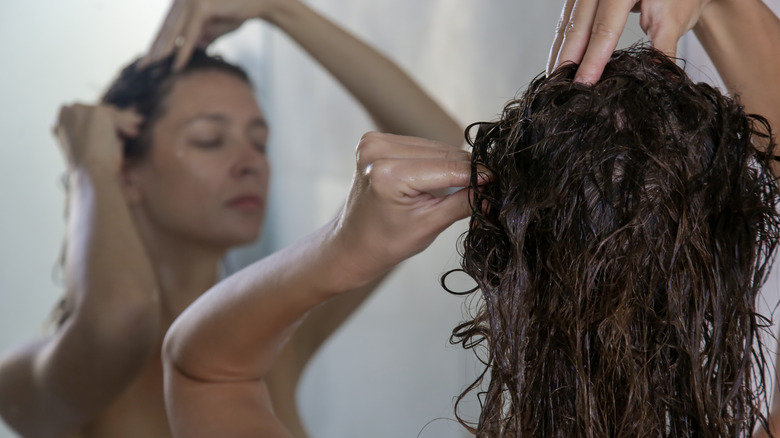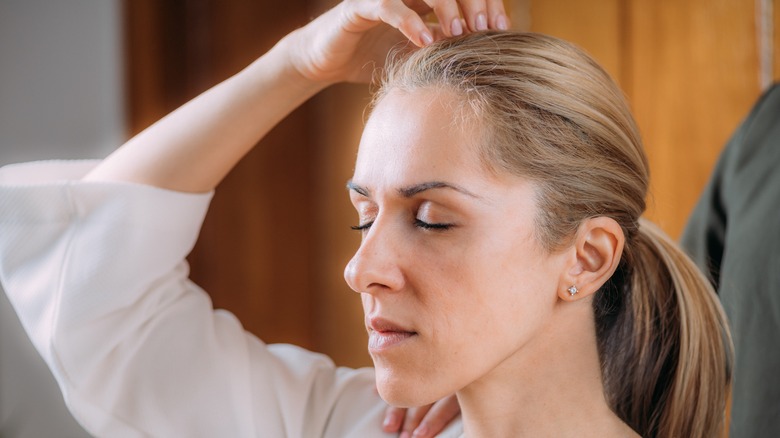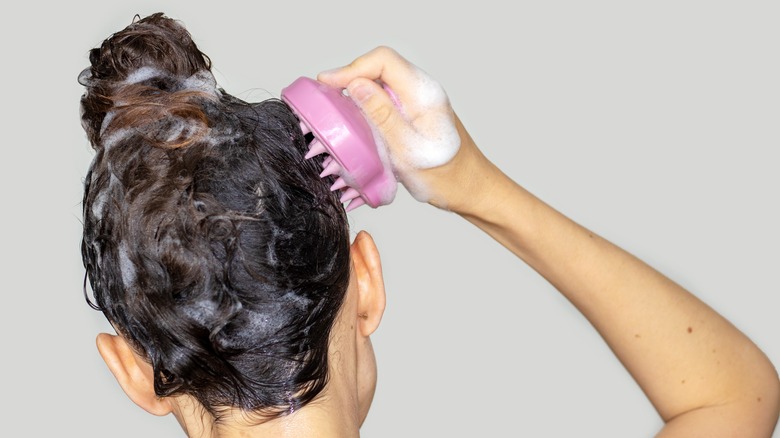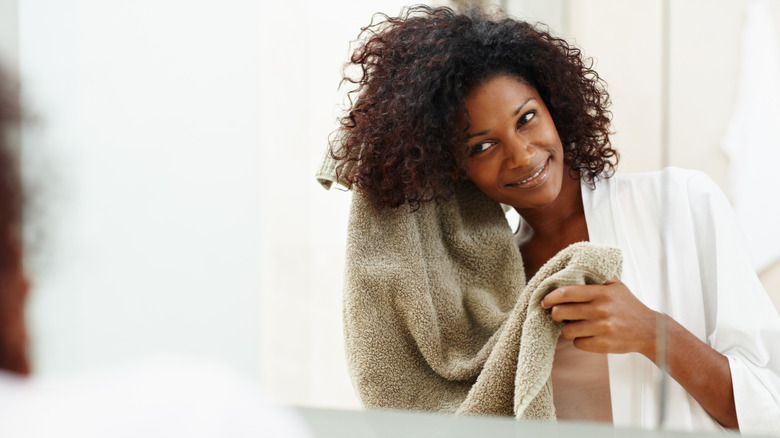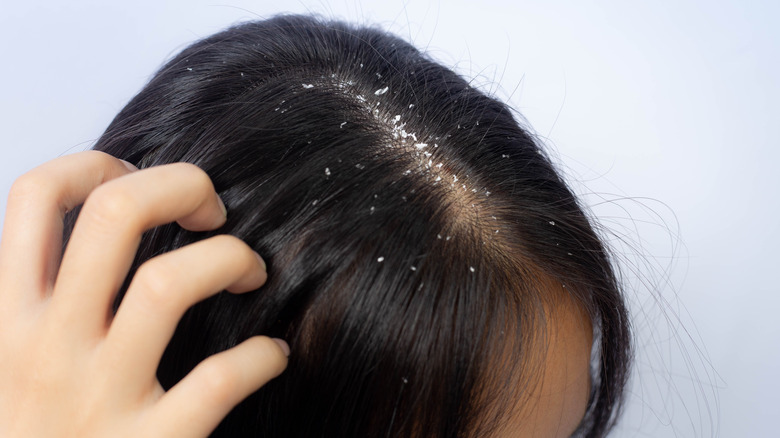Hair Tapping 101: What It Is & The Benefits To Know About It
One of the best parts of visiting the hair salon is the scalp massage we get while an attendant shampoos and conditions our hair. As it turns out, there are some big health benefits to this relaxing treatment. First is its capability to decrease one's stress hormone levels, blood pressure, and heart rate when done for 15 to 25 minutes. Second, a scalp massage can encourage thicker hair growth by stretching the hair follicles' cells and the blood vessels underneath the skin, as discovered by two different studies. Though the results of one of these studies were self-reported by the participants, the findings still signal the potential that scalp stimulation holds for hair health and growth.
This makes hair tapping a promising technique for those who a) experience hair loss, and b) don't have the time or resources to avail themselves of a regular scalp massage. As its name implies, hair tapping has you patting all over your scalp with your fingertips in a gentle but quick manner. It's a type of massage that you can master on your own while you shower and even when your hair is dry.
Tapping releases tension and encourages circulation
If hair tapping sounds familiar, that is because you might have already heard about Emotional Freedom Technique tapping (EFT). According to WebMD, during the 1970s, doctors discovered how tapping the acupressure points on their patients' faces and bodies helped them deal better with anxiety and stress. This led to the development of EFT. Much like acupuncture (but minus the needles), it stimulates the acupoints of the body to improve the flow of energy.
EFT is often mentioned in discussions about treating mental health issues like anxiety and post-traumatic stress disorder. However, several studies show that it has physiological benefits too. One conducted in 2011 discovered how tapping improved the skin conditions of participants with psoriasis. Meanwhile, veterans who participated in a 2013 one saw the frequency and intensity of their headache tensions decrease by more than 50%. Furthermore, a 2012 study discovered how EFT can reduce stress hormones in the body. These findings lend validity to tapping's potential to address hair growth problems since stress is one of the risk factors for hair loss or alopecia according to Mayo Clinic.
The scalp is a good area to stimulate, either through tapping or a massage. "We tend to hold a lot of tension across our hairline, behind our ears, and in the neck," hairstylist Christophe Robin told MindBodyGreen. "[This] is mostly due to stress and partly to posture." Firm pressure applied rhythmically helps release the tension and encourage blood circulation to facilitate hair growth.
How to do hair tapping
It's easy to squeeze in a 5- or 10-minute hair-tapping session while taking a shower. You can do it while shampooing (this also helps the shampoo cleanse the scalp more thoroughly) or while letting your strands absorb your conditioner. Guerlain training director Laura Romero's advice (per Vogue) is to do traditional massage strokes first to prep the skin before tapping. Start at your hairline, going up to the crown then make circular and slightly dragging movements down to the nape. "It is important to press lightly to drain the scalp, which is as much an extension of our skin as our nails," Romero said. You can then start tapping with your fingertips, following the same pattern.
Avoid using your fingernails as they could scratch the skin and snag on your strands, causing breakage. For days when you have gel or acrylic nails on, use scalp-massaging tools like a shampoo brush with silicone bristles on wet hair and a paddle hairbrush with flexible bristles on dry hair. They double as exfoliators, ridding the scalp of dead skin cells and buildup.
Hair tapping can also be done when your hair is dry while you binge on your comfort TV shows at night, or whenever you're taking a desk break at work. Make it feel more luxurious by pairing the activity with hair oiling. Moisturize your hands with a hair- and scalp-nourishing oil like coconut, Moroccan, or castor oil to minimize friction between your fingers, scalp, and locks.
Consistent practice yields hair tapping's benefits
Another good thing about hair tapping is how conveniently you can fit it into your daily schedule, thus offering you greater chances of reaping the benefits. Dermatologist Dr. Raechele Cochran Gathers told MindBodyGreen, "Beautiful, strong hair depends on good blood circulation, proper nutrition, and a healthy and supple scalp." A regular hair tapping and scalp massage practice facilitates the achievement of the first and third requirements since both techniques help the scalp receive an adequate supply of blood, oxygen, and nutrients it needs to grow healthy locks.
Don't be discouraged if your hair doesn't seem lusher after a few weeks. In one of the studies on scalp massage, it took 24 weeks of daily 4-minute massages to achieve 0.007 millimeters of growth in hair thickness. Enjoy the relaxing sensation of stimulating your scalp and know that the tension you are releasing ultimately benefits the health of your hair in the long run.
What to be careful of when hair tapping
Certain precautions must be taken in case you have dandruff or suffer from acne, eczema, or psoriasis on your scalp. The inevitable friction from tapping and rubbing the skin, either with your fingers or with a scalp massage tool, might aggravate your condition further, especially if you use oils and non-prescription hair care products. Consult your dermatologist first to address the issue.
While pressure is the key component in stimulating the hair follicles, take care not to apply too much of it, especially when doing pre-tapping massage strokes. If a part of your scalp begins to feel irritated or painful, you may be tapping or rubbing too forcefully. Don't feel obligated to tap longer than what feels comfortable, especially if you rarely get your scalp massaged. You can ease into a regular hair-tapping practice by doing it just a few minutes a day and then building up your tolerance for it.
